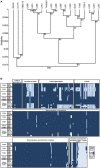Zoonotic Transmission of Campylobacter jejuni to Caretakers From Sick Pen Calves Carrying a Mixed Population of Strains With and Without Guillain Barré Syndrome-Associated Lipooligosaccharide Loci
- PMID: 35591997
- PMCID: PMC9112162
- DOI: 10.3389/fmicb.2022.800269
Zoonotic Transmission of Campylobacter jejuni to Caretakers From Sick Pen Calves Carrying a Mixed Population of Strains With and Without Guillain Barré Syndrome-Associated Lipooligosaccharide Loci
Abstract
Campylobacter jejuni causes foodborne gastroenteritis and may trigger acute autoimmune sequelae including Guillain Barré Syndrome. Onset of neuromuscular paralysis is associated with exposure to C. jejuni lipooligosaccharide (LOS) classes A, B, C, D, and E that mimic and evoke antibodies against gangliosides on myelin and axons of peripheral nerves. Family members managing a Michigan dairy operation reported recurring C. jejuni gastroenteritis. Because dairy cattle are known to shed C. jejuni, we hypothesized that calves in the sick pen were the source of human infections. Fecal samples obtained from twenty-five calves, one dog, and one asymptomatic family member were cultured for Campylobacter. C. jejuni isolates were obtained from thirteen calves and the family member: C. coli from two calves, and C. hyointestinalis from two calves. Some calves had diarrhea; most were clinically normal. Typing of lipooligosaccharide biosynthetic loci showed that eight calf C. jejuni isolates fell into classes A, B, and C. Two calf isolates and the human isolate possessed LOS class E, associated mainly with enteric disease and rarely with Guillain Barré Syndrome. Multi-locus sequence typing, porA and flaA typing, and whole genome comparisons of the thirteen C. jejuni isolates indicated that the three LOS class E strains that included the human isolate were closely related, indicating zoonotic transmission. Whole-genome comparisons revealed that isolates differed in virulence gene content, particularly in loci encoding biosynthesis of surface structures. Family members experienced diarrheal illness repeatedly over 2 years, yet none experienced GBS despite exposure to calves carrying invasive C. jejuni with LOS known to elicit antiganglioside autoantibodies.
Keywords: Campylobacter jejuni; Guillain Barré Syndrome; autoimmunity; gastrointestinal inflammation; outbreak investigation; zoonoses.
Copyright © 2022 St. Charles, Brooks, Bell, Ahmed, Van Allen, Manning and Mansfield.
Conflict of interest statement
The authors declare that the research was conducted in the absence of any commercial or financial relationships that could be construed as a potential conflict of interest.
Figures





Similar articles
-
Genomic variability of lipooligosaccharide biosynthesis locus and sequence type among Campylobacter jejuni isolated from patients with Guillain-Barré syndrome.Microbiol Spectr. 2025 Aug 5;13(8):e0006225. doi: 10.1128/spectrum.00062-25. Epub 2025 Jul 9. Microbiol Spectr. 2025. PMID: 40631742 Free PMC article.
-
Virulence and infectious assessment of a Campylobacter jejuni strain isolated from California gull.Microbiol Spectr. 2025 May 6;13(5):e0170524. doi: 10.1128/spectrum.01705-24. Epub 2025 Mar 18. Microbiol Spectr. 2025. PMID: 40099986 Free PMC article.
-
Emergence and Molecular Epidemiology of Campylobacter jejuni ST-2993 Associated with a Large Outbreak of Guillain-Barré Syndrome in Peru.Microbiol Spectr. 2022 Oct 26;10(5):e0118722. doi: 10.1128/spectrum.01187-22. Epub 2022 Aug 16. Microbiol Spectr. 2022. PMID: 35972275 Free PMC article.
-
An Updated Classification System and Review of the Lipooligosaccharide Biosynthesis Gene Locus in Campylobacter jejuni.Front Microbiol. 2020 May 19;11:677. doi: 10.3389/fmicb.2020.00677. eCollection 2020. Front Microbiol. 2020. PMID: 32508756 Free PMC article. Review.
-
Autoimmunity and cytokines in Guillain-Barré syndrome revisited: review of pathomechanisms with an eye on therapeutic options.Eur Cytokine Netw. 2019 Mar 1;30(1):1-14. doi: 10.1684/ecn.2019.0424. Eur Cytokine Netw. 2019. PMID: 31074417 Review.
Cited by
-
Lithium alleviates paralysis in experimental autoimmune neuritis in Lewis rats by modulating glycogen synthase kinase-3β activity.J Vet Sci. 2024 Sep;25(5):e69. doi: 10.4142/jvs.24212. J Vet Sci. 2024. PMID: 39363657 Free PMC article.
-
Genetic characteristics, antimicrobial susceptibility, and virulence genes distribution of Campylobacter isolated from local dual-purpose chickens in central China.Front Cell Infect Microbiol. 2023 Sep 7;13:1236777. doi: 10.3389/fcimb.2023.1236777. eCollection 2023. Front Cell Infect Microbiol. 2023. PMID: 37743858 Free PMC article.
-
Triggers of Guillain-Barré Syndrome: Campylobacter jejuni Predominates.Int J Mol Sci. 2022 Nov 17;23(22):14222. doi: 10.3390/ijms232214222. Int J Mol Sci. 2022. PMID: 36430700 Free PMC article.
-
Campylobacter jejuni Response When Inoculated in Bovine In Vitro Fecal Microbial Consortia Incubations in the Presence of Metabolic Inhibitors.Pathogens. 2023 Nov 26;12(12):1391. doi: 10.3390/pathogens12121391. Pathogens. 2023. PMID: 38133276 Free PMC article.
References
-
- Aksomaitiene J., Ramonaite S., Tamuleviciene E., Novoslavskij A., Alter T., Malakauskas M. (2019). Overlap of antibiotic resistant Campylobacter jejuni MLST genotypes isolated from humans, broiler products, dairy cattle and wild birds in Lithuania. Front. Microbiol. 10:1377. 10.3389/fmicb.2019.01377 - DOI - PMC - PubMed
-
- Al-Edany A. A., Khudor M. H., Radhi L. Y. (2015). Isolation, identification and toxigenic aspects of Campylobacter jejuni isolated from slaughtered cattle and sheep at Basrah city. Basrah J. Vet. Res. 14 316–327.
LinkOut - more resources
Full Text Sources
Molecular Biology Databases

